Trees Birds Mammals Fish Amphibians Reptiles
Wild Algarve
Bookshop
Lactarius uvidus (Fr.) Fr. - Shiner
Phylum: Basidiomycota - Class: Agaricomycetes - Order: Russulales - Family: Russulaceae
Distribution - Taxonomic History - Etymology - Identification - Culinary Notes - Reference Sources
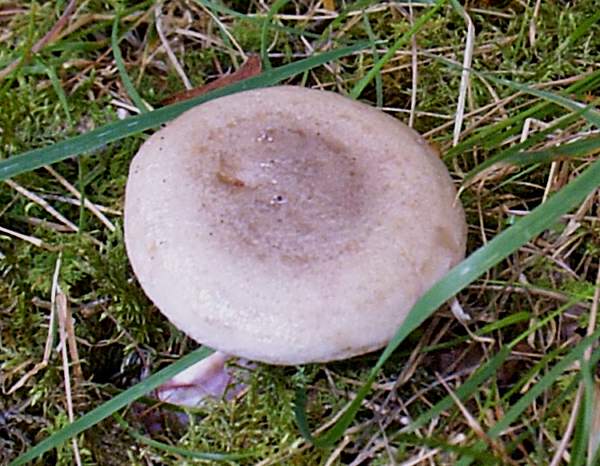
Lactarius uvidus (which does not have a generally accepted common name) grows in wet places, mainly under
willow and birch on acid soils. If asked to suggest a common name for this mushroom, it would have to be the Lilac-staining Milkcap.
Distribution
An infrequent find in southern
Britain, Lactarius uvidus is rather more common in some parts of Scotland and in
northern mainland Europe.
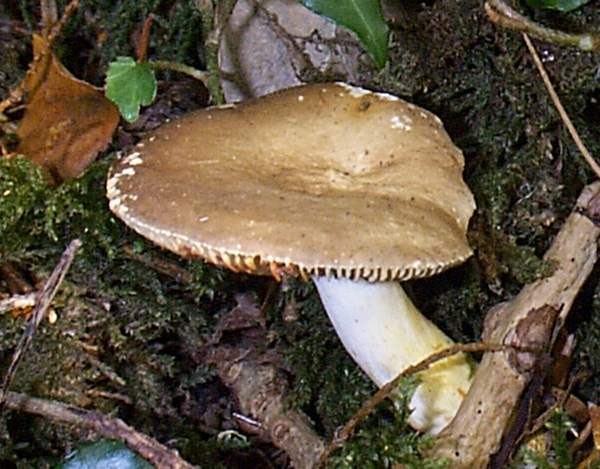
Lactarius uvidus is recorded also from the eastern side of North America, but whether the milkcaps (generally written as Milk Caps in the USA) are co-specific with their European counterparts is as yet unconfirmed.
Taxonomic history
This milkcap mushroom was first described in 1818 by the renowned Swedish mycologist Elias Magnus Fries who gave it the binomial scientific name Agaricus uvidus. Two decades later, in 1838, Fries transferred the species to its present genus, whereupon it became Lactarius uvidus, which is its currently-accepted scientific name.
Synonyms of Lactarius uvidus include Agaricus lividorubescens Batsch, Agaricus livens J.F.Gmel., Agaricus uvidus Fr., Galorrheus uvidus (Fr.) P.Kumm., and Lactarius lividorubescens (Batsch) Burl.
Etymology
The generic name Lactarius means producing milk (lactating) - a reference to the milky latex that is exuded from the gills of milkcap fungi when they are cut or torn. The specific epithet uvidus means damp or humid and is a reference to the habitat preference of this species.
Identification Guide
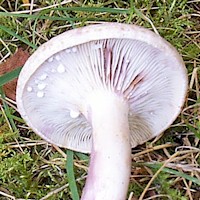 |
The lilaceous staining on damaged gills is a distinctive feature of this milkcap; it is very clearly visible on the
gills of this pale young specimen (left). |
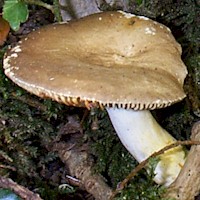 |
Cap
Pale violet grey when young, this deceptive milkcap
becomes much darker and browner as the fruiting body matures.
4 to 9cm in diameter, convex and then flat or
slightly depressed, the caps are buff or lilaceous, darkening with age.
When cut, the firm flesh below the cuticle is buff but eventually turns
lilaceous. |
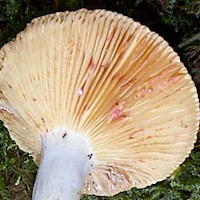
|
Gills
Shortly decurrent and fairly crowded, the pale
gills darken with age. When damaged, the gills release a white milk that very slowly turns
lilaceous as it dries.
Stem
6 to 25mm in diameter and 3 to 6cm tall, the pale stems are cylindrical
and become hollow with age. |
| |
Spores
Subglobose to broadly ellipsoidal, 9-10 x 7.5-8.5 μm, hyaline; ornamented with broad ridges 0.5-1 µm tall; forming an incomplete reticulum.
Spore print
Pale cream. |
Odour/taste |
Slightly fruity but indistinctive odour; bitter taste. |
Habitat & Ecological role |
Under willow and birch in damp woodland; less frequently under
conifers. |
Season |
August to October in Britain and Ireland. |
Similar species |
Lactarius quietus also
has a buff cap, but it is found only under oaks and its milk does not
turn lilac as it dries. |
Culinary Notes
This distinctive species is bitter tasting, It is considered inedible and some say that it might be poisonous.
Reference Sources
Pat O'Reilly (2016). Fascinated by Fungi, First Nature Publishing
Jacob Heilmann-Clausen, Annemieke Verbeken, & Jan Vesterholt (1998). The Genus Lactarius (Fungi of Northern Europe—Vol. 2) The Danish Mycological Society.
Funga Nordica, Henning Knudsen and Jan Vesterholt, 2008.
Fungi of Switzerland, volume 6: Russulaceae, Kränzlin, F.
BMS List of English Names for Fungi.
Paul M. Kirk, Paul F. Cannon, David W. Minter and J. A. Stalpers. (2008). Dictionary of the Fungi; CABI.
Taxonomic history and synonym information on these pages is drawn from many sources but in particular from the British Mycological Society's GB Checklist of Fungi.
Top of page...
Fascinated by Fungi. Back by popular demand, Pat O'Reilly's best-selling 450-page hardback book is available now. The latest second edition was republished with a sparkling new cover design in September 2022 by Coch-y-Bonddu Books. Full details and copies are available from the publisher's online bookshop...